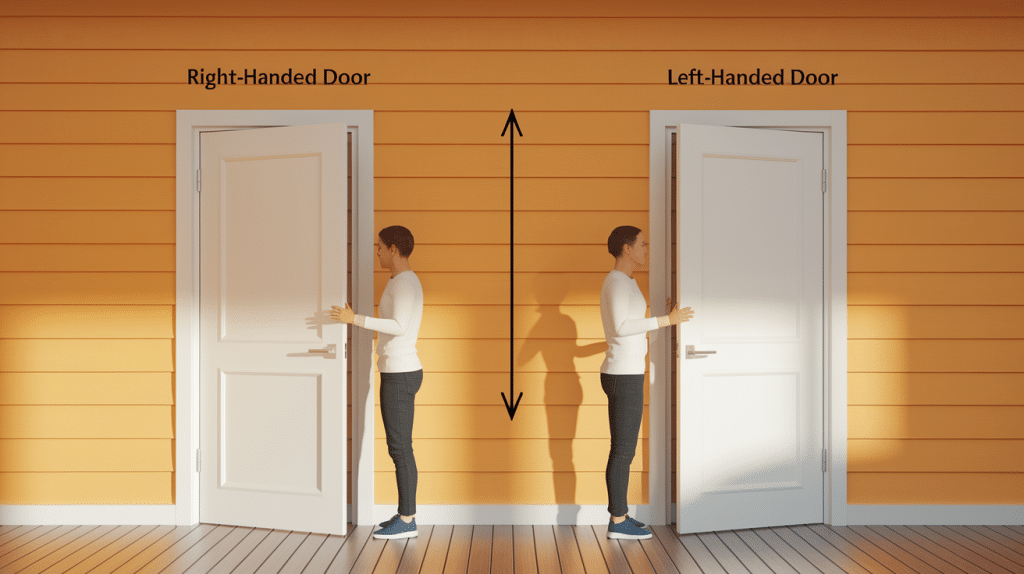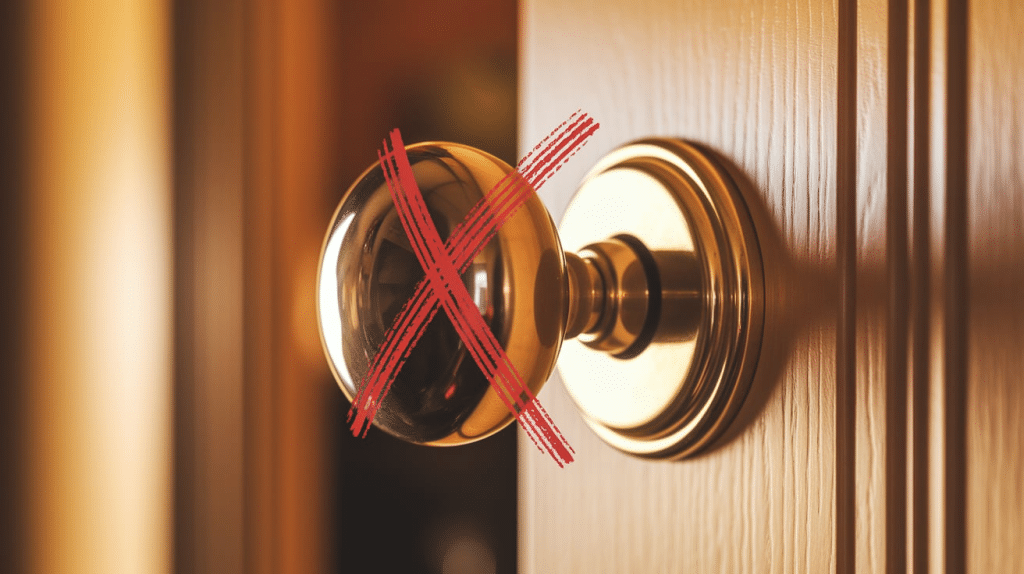Ever wondered why your door installer keeps asking about “left-hand” or “right-hand” doors and felt completely confused?
You’re definitely not alone!
Door handing might sound like technical jargon, but it’s actually a simple concept that becomes crucial when buying, installing, or replacing doors and hardware.
Getting it wrong can lead to expensive mistakes, improper installations, and doors that swing the wrong way.
Understand what door handing really means, learn about foolproof methods to determine your door’s handing, and share insider tips to avoid the common pitfalls that trip up even experienced homeowners.
What Does Door Handing Mean?
Door handing, also known as “door swing,” is a fundamental concept that describes two critical aspects of how a door operates: the direction it opens (inward or outward) and which side the hinges are mounted on (left or right).
This simple classification system helps manufacturers, contractors, and homeowners communicate precisely about door specifications without confusion.
Think of door handing as a door’s “personality”; it determines exactly how the door will behave in its frame.
A left-hand door has hinges on the left side when viewed from the approach side, while a right-hand door has hinges on the right side. The “approach side” is typically the side from which you pull the door open.
This classification directly impacts the hardware you’ll need.
Door handles, locks, latches, and even decorative hardware are manufactured specifically for left-hand or right-hand applications. Installing the wrong-handed hardware can result in upside-down locks, handles that don’t align properly, or security features that don’t function correctly.
Why Door Handing Matters
- Hardware Compatibility: The most critical reason for understanding door handing is ensuring your locks, handles, and latches fit and function properly.
- Installation Accuracy: Contractors and installers rely on hand specifications to pre-hang doors correctly, ensuring smooth operation and proper fit within the frame.
- Replacement Precision: When replacing existing doors or hardware, knowing the correct handing prevents costly mistakes and ensures seamless integration with your existing setup
Note: Door handing primarily applies to traditional hinged doors, both interior and exterior. Sliding doors, pocket doors, and bifold doors typically don’t require handing specifications since they operate on different mechanisms.
Right-Handed vs. Left-Handed Door Explained
Understanding the difference between right-handed and left-handed doors is simpler than you think; it’s all about hinge placement.
| Type of Door | Hinge Location | How to Open | Push Side vs. Pull Side |
|---|---|---|---|
| Right-Handed Door | Hinges are on the right side when you face the door and push it away from you to open. | Push the door away from you; it swings open to the right. | Push side: opens outward. Pull side: door swings toward you from the right. |
| Left-Handed Door | Hinges are on the left side when you face the door and push it away from you to open. | Push the door away from you; it swings open to the left. | Push side: opens outward. Pull side: door swings toward you from the left. |
How to Determine the Handing of a Door

Follow this foolproof method to identify your door’s handing every time:
Step 1: Position yourself so your back is facing the hinge side of the door—the side where you can see the hinges mounted on the door frame.
Step 2: From this position, push the door open away from you.
Step 3: Observe which side the hinges are on:
- If the hinges are on your right side as the door swings away → Right-Handed Door
- If the hinges are on your left side as the door swings away → Left-Handed Door
Quick Alternative Method: Some people prefer the “push or pull” approach. Stand facing the door in its normal operating position. If you pull the door toward you and the handle is on the right, it’s a right-hand door. If the handle is on the left when pulling toward you, it’s a left-hand door.
Pro Tip: Consider adding a simple diagram showing a person standing with their back to the hinges, with arrows indicating door swing direction. This visual reference makes the concept instantly clear and eliminates confusion.
Common Mistakes and How to Avoid Them

Even experienced homeowners make door-handing errors. Here’s how to avoid the most costly and frustrating mistakes.
1. Mistaking Push vs. Pull: Always Confirm Which Side You’re Standing On
The most frequent error occurs when people determine the handle from the wrong side of the door. Always position yourself on the side where you can see the hinges, then push the door away from you.
Never determine handing by pulling the door toward you, as this reverses the perspective and leads to incorrect identification every time.
2. Mixing Up Interior vs. Exterior References
Interior and exterior doors can create confusion about which side is the “approach side.” For exterior doors, always stand outside looking at the door.
For interior doors, stand on the side you typically approach from when opening. Consistency in your reference point prevents mix-ups between rooms or when dealing with multiple doors throughout your home.
3. Skipping Diagrams or Professional Consultation When Unsure
Many people rush through, handing out determination without visual aids or expert advice. When in doubt, sketch a simple diagram showing your door’s position, hinge location, and swing direction.
Don’t hesitate to consult with hardware store professionals or contractors who deal with door handing daily; their expertise can save you from expensive mistakes.
4. Buying Pre-Hung Doors Without Checking Handing First
Pre-hung doors come with hinges already installed, making handing changes extremely difficult or impossible. Always measure and confirm your existing door’s handing before purchasing replacements.
Once a pre-hung door is delivered with the wrong handing, you’re typically stuck with expensive returns, restocking fees, or complete door frame modifications to accommodate the incorrect swing.
Conclusion
Door handles don’t have to be intimidating once you understand the basics; it’s simply about hinge placement and swing direction.
A few minutes spent correctly identifying your door’s handing can save you hundreds of dollars and countless headaches.
Always double-check your measurements before placing orders, and remember there’s no shame in asking for professional guidance when you’re uncertain.
Doesn’t matter if you’re a DIY enthusiast or hiring professionals, getting door handing right the first time makes all the difference.
Have questions about your specific door situation or helpful tips to share? Drop them in the comments below; your experience could help fellow homeowners avoid costly mistakes!


